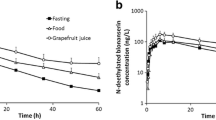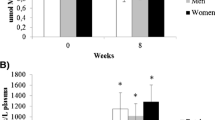Abstract
4β-Hydroxycholesterol (4βOHC) is an endogenous CYP3A4 metabolite. However, it is unclear whether circulating levels of 4βOHC may reflect hepatic CYP3A4 activity or both hepatic and intestinal enzyme activity. The aim of this study was to investigate the effect of grapefruit juice, regarded to be a selective intestinal CYP3A4 inhibitor, on serum 4βOHC levels in healthy volunteers. The participants (n = 22) consumed grapefruit juice twice daily for 3 weeks followed by a 2-week washout period. Blood samples for measurements of 4βOHC and the non-CYP3A4-derived oxysterols 24-hydroxycholesterol (24OHC) and 27-hydroxycholesterol (27OHC), as well as lathosterol and total cholesterol, were drawn on days 0, 7, 21, and 35. Median individual changes (ratios) in cholesterol-corrected 4βOHC levels from baseline to weeks 1, 3, and 5 were 0.94 (P = 0.2), 0.98 (P = 0.3), and 0.97 (P = 0.9), respectively. In comparison, median changes (ratios) in cholesterol-corrected levels of 24OHC at the same points were 1.01 (P = 0.6), 0.98 (P = 0.3), and 0.99 (P = 0.5), and of 27OHC 1.01 (P = 0.8), 0.97 (P = 0.5), and 0.99 (P = 0.2). Surprisingly, serum concentration of cholesterol was significantly reduced by approximately 5% after 1 week (P = 0.03), while median cholesterol-corrected levels of lathosterol increased significantly and persistently by approximately 15% during the whole 5-week period (P < 0.04). In conclusion, the present findings suggest that intestinal CYP3A4 is not relevant for the overall formation of 4βOHC in healthy volunteers. The fact that grapefruit juice altered cholesterol homeostasis should be further investigated.



Similar content being viewed by others
References
Zanger UM, Schwab M. Cytochrome P450 enzymes in drug metabolism: regulation of gene expression, enzyme activities, and impact of genetic variation. Pharmacol Ther. 2013;138:103–41.
Wilkinson GR. Drug metabolism and variability among patients in drug response. N Engl J Med. 2005;352:2211–21.
Tracy TS, Chaudhry AS, Prasad B, Thummel KE, Schuetz EG, Zhong XB, et al. Interindividual variability in cytochrome P450-mediated drug metabolism. Drug Metab Dispos. 2016;44:343–51.
Diczfalusy U, Miura J, Roh HK, Mirghani RA, Sayi J, Larsson H, et al. 4β-Hydroxycholesterol is a new endogenous CYP3A marker: relationship to CYP3A5 genotype, quinine 3-hydroxylation and sex in Koreans, Swedes and Tanzanians. Pharmacogenet Genomics. 2008;18:201–8.
Lamba V, Panetta JC, Strom S, Schuetz EG. Genetic predictors of interindividual variability in hepatic CYP3A4 expression. J Pharmacol Exp Ther. 2010;332:1088–99.
Kotlyar M, Carson SW. Effects of obesity on the cytochrome P450 enzyme system. Int J Clin Pharmacol Ther. 1999;37:8–19.
Ulvestad M, Skottheim IB, Jakobsen GS, Bremer S, Molden E, Asberg A, et al. Impact of OATP1B1, MDR1, and CYP3A4 expression in liver and intestine on interpatient pharmacokinetic variability of atorvastatin in obese subjects. Clin Pharmacol Ther. 2013;93:275–82.
Klein K, Zanger UM. Pharmacogenomics of cytochrome P450 3A4: recent progress toward the “missing heritability” problem. Front Genet. 2013;4:12.
Fuhr U, Jetter A, Kirchheiner J. Appropriate phenotyping procedures for drug metabolizing enzymes and transporters in humans and their simultaneous use in the “cocktail” approach. Clin Pharmacol Ther. 2007;81:270–83.
Mao J, Martin I, McLeod J, Nolan G, van Horn R, Vourvahis M, et al. Perspective: 4β-hydroxycholesterol as an emerging endogenous biomarker of hepatic CYP3A. Drug Metab Rev. 2017;49:18–34.
Shin KH, Choi MH, Lim KS, Yu KS, Jang IJ, Cho JY. Evaluation of endogenous metabolic markers of hepatic CYP3A activity using metabolic profiling and midazolam clearance. Clin Pharmacol Ther. 2013;94:601–9.
Gjestad C, Haslemo T, Andreassen OA, Molden E. 4β-Hydroxycholesterol level significantly correlates with steady-state serum concentration of the CYP3A4 substrate quetiapine in psychiatric patients. Br J Clin Pharmacol. 2017;83:2398–405.
Björkhem-Bergman L, Bäckström T, Nylén H, Rönquist-Nii Y, Bredberg E, Andersson TB, et al. Comparison of endogenous 4β-hydroxycholesterol with midazolam as markers for CYP3A4 induction by rifampicin. Drug Metab Dispos. 2013;41:1488–93.
Diczfalusy U, Nylén H, Elander P, Bertilsson L. 4β-Hydroxycholesterol, an endogenous marker of CYP3A4/5 activity in humans. Br J Clin Pharmacol. 2011;71:183–9.
Bodin K, Bretillon L, Aden Y, Bertilsson L, Broomé U, Einarsson C, et al. Antiepileptic drugs increase plasma levels of 4β-hydroxycholesterol in humans: evidence for involvement of cytochrome p450 3A4. J Biol Chem. 2001;276:38685–9.
Bodin K, Andersson U, Rystedt E, Ellis E, Norlin M, Pikuleva I, et al. Metabolism of 4β-hydroxycholesterol in humans. J Biol Chem. 2002;277:31534–40.
Nitta SI, Hashimoto M, Kazuki Y, Takehara S, Suzuki H, Oshimura M, et al. Evaluation of 4β-hydroxycholesterol and 25-hydroxycholesterol as endogenous biomarkers of CYP3A4: study with CYP3A-humanized mice. AAPS J. 2018;20:61.
Gjestad C, Huynh DK, Haslemo T, Molden E. 4β-Hydroxycholesterol correlates with dose but not steady-state concentration of carbamazepine: indication of intestinal CYP3A in biomarker formation? Br J Clin Pharmacol. 2016;81:269–76.
Hole K, Wollmann BM, Nguyen C, Haslemo T, Molden E. Comparison of CYP3A4-inducing capacity of enzyme-inducing antiepileptic drugs using 4β-hydroxycholesterol as biomarker. Br J Clin Pharmacol. 2018;40:463–8.
Kanebratt KP, Diczfalusy U, Bäckström T, Sparve E, Bredberg E, Böttiger Y, et al. Cytochrome P450 induction by rifampicin in healthy subjects: determination using the Karolinska cocktail and the endogenous CYP3A4 marker 4β-hydroxycholesterol. Clin Pharmacol Ther. 2008;84:589–94.
Lütjohann D, Marinova M, Schneider B, Oldenburg J, von Bergmann K, Bieber T, et al. 4β-Hydroxycholesterol as a marker of CYP3A4 inhibition in vivo—effects of itraconazole in man. Int J Clin Pharmacol Ther. 2009;47:709–15.
Neuhoff S, Tucker GT. Was 4β-hydroxycholesterol ever going to be a useful marker of CYP3A4 activity? Br J Clin Pharmacol. 2018;84:1620–1.
Tomalik-Scharte D, Lutjohann D, Doroshyenko O, Frank D, Jetter A, Fuhr U. Plasma 4β-hydroxycholesterol: an endogenous CYP3A metric? Clin Pharmacol Ther. 2009;86:147–53.
Vanhove T, de Jonge H, de Loor H, Annaert P, Diczfalusy U, Kuypers DR. Comparative performance of oral midazolam clearance and plasma 4β-hydroxycholesterol to explain interindividual variability in tacrolimus clearance. Br J Clin Pharmacol. 2016;82:1539–49.
DeGorter MK, Tirona RG, Schwarz UI, Choi YH, Dresser GK, Suskin N, et al. Clinical and pharmacogenetic predictors of circulating atorvastatin and rosuvastatin concentrations in routine clinical care. Circ Cardiovasc Genet. 2013;6:400–8.
Dutreix C, Lorenzo S, Wang Y. Comparison of two endogenous biomarkers of CYP3A4 activity in a drug-drug interaction study between midostaurin and rifampicin. Eur J Clin Pharmacol. 2014;70:915–20.
Björkhem-Bergman L, Bäckström T, Nylén H, Rönquist-Nii Y, Bredberg E, Andersson TB, et al. Quinine compared to 4β-hydroxycholesterol and midazolam as markers for CYP3A induction by rifampicin. Drug Metab Pharmacokinet. 2014;29:352–5.
Russell DW. Cholesterol biosynthesis and metabolism. Cardiovasc Drugs Ther. 1992;6:103–10.
Lown KS, Kolars JC, Thummel KE, Barnett JL, Kunze KL, Wrighton SA, et al. Interpatient heterogeneity in expression of CYP3A4 and CYP3A5 in small bowel. Lack of prediction by the erythromycin breath test. Drug Metab Dispos. 1994;22:947–55.
Bailey DG, Malcolm J, Arnold O, Spence JD. Grapefruit juice-drug interactions. 1998. Br J Clin Pharmacol. 2004;58:S831–40 discussion S41–3.
Yang J, Liao M, Shou M, Jamei M, Yeo KR, Tucker GT, et al. Cytochrome p450 turnover: regulation of synthesis and degradation, methods for determining rates, and implications for the prediction of drug interactions. Curr Drug Metab. 2008;9:384–94.
Uesawa Y, Abe M, Mohri K. White and colored grapefruit juice produce similar pharmacokinetic interactions. Pharmazie. 2008;63:598–600.
Dzeletovic S, Breuer O, Lund E, Diczfalusy U. Determination of cholesterol oxidation products in human plasma by isotope dilution-mass spectrometry. Anal Biochem. 1995;225:73–80.
Acimovic J, Lövgren-Sandblom A, Monostory K, Rozman D, Golicnik M, Lütjohann D, et al. Combined gas chromatographic/mass spectrometric analysis of cholesterol precursors and plant sterols in cultured cells. J Chromatogr B Analyt Technol Biomed Life Sci. 2009;877:2081–6.
Mulvihill EE, Allister EM, Sutherland BG, Telford DE, Sawyez CG, Edwards JY, et al. Naringenin prevents dyslipidemia, apolipoprotein B overproduction, and hyperinsulinemia in LDL receptor-null mice with diet-induced insulin resistance. Diabetes. 2009;58:2198–210.
Iqbal J, Hussain MM. Intestinal lipid absorption. Am J Physiol Endocrinol Metab. 2009;296:E1183–94.
Hussain MM. Intestinal lipid absorption and lipoprotein formation. Curr Opin Lipidol. 2014;25:200–6.
Diczfalusy U, Kanebratt KP, Bredberg E, Andersson TB, Bottiger Y, Bertilsson L. 4β-hydroxycholesterol as an endogenous marker for CYP3A4/5 activity. Stability and half-life of elimination after induction with rifampicin. Br J Clin Pharmacol. 2009;67:38–43.
Ramsden D, Zhou J, Tweedie DJ. Determination of a degradation constant for CYP3A4 by direct suppression of mRNA in a novel human hepatocyte model, HepatoPac. Drug Metab Dispos. 2015;43:1307–15.
Lilja JJ, Kivisto KT, Neuvonen PJ. Duration of effect of grapefruit juice on the pharmacokinetics of the CYP3A4 substrate simvastatin. Clin Pharmacol Ther. 2000;68:384–90.
Liu C, Shang YF, Zhang XF, Zhang XG, Wang B, Wu Z, et al. Co-administration of grapefruit juice increases bioavailability of tacrolimus in liver transplant patients: a prospective study. Eur J Clin Pharmacol. 2009;65:881–5.
Fukazawa I, Uchida N, Uchida E, Yasuhara H. Effects of grapefruit juice on pharmacokinetics of atorvastatin and pravastatin in Japanese. Br J Clin Pharmacol. 2004;57:448–55.
Gjestad C, Haslemo T, Andreassen OA, Molden E. Gjestad et al. reply to ‘Was 4β-hydroxycholesterol ever going to be a useful marker of CYP3A4 activity?’ by Neuhoff and Tucker. Br J Clin Pharmacol. 2018;84:1624–5.
Acknowledgments
We acknowledge the South-Eastern Norway Regional Health Authority for PhD funding to author C. G. Moreover, we are grateful to the Department of Medical Biochemistry at Diakonhjemmet Hospital for performing measurements of cholesterol.
Author information
Authors and Affiliations
Corresponding author
Ethics declarations
The study was approved by the Regional Committee for Medical and Health Research Ethics and the Hospital’s Research Committee, and written informed consent was obtained from all participants.
Additional information
Publisher’s Note
Springer Nature remains neutral with regard to jurisdictional claims in published maps and institutional affiliations.
Electronic Supplementary Material
ESM 1
(DOCX 15 kb)
Rights and permissions
About this article
Cite this article
Gjestad, C., Hole, K., Haslemo, T. et al. Effect of Grapefruit Juice Intake on Serum Level of the Endogenous CYP3A4 Metabolite 4β-Hydroxycholesterol—an Interaction Study in Healthy Volunteers. AAPS J 21, 58 (2019). https://doi.org/10.1208/s12248-019-0330-1
Received:
Accepted:
Published:
DOI: https://doi.org/10.1208/s12248-019-0330-1




